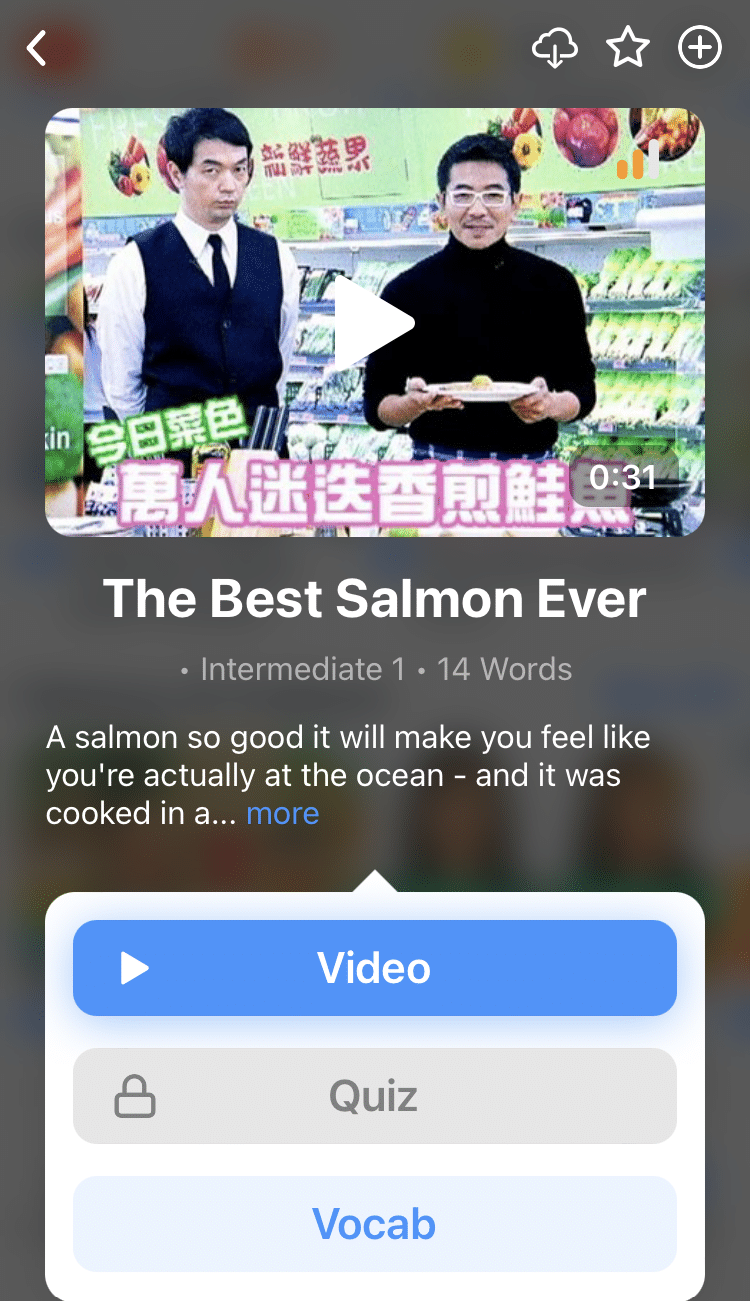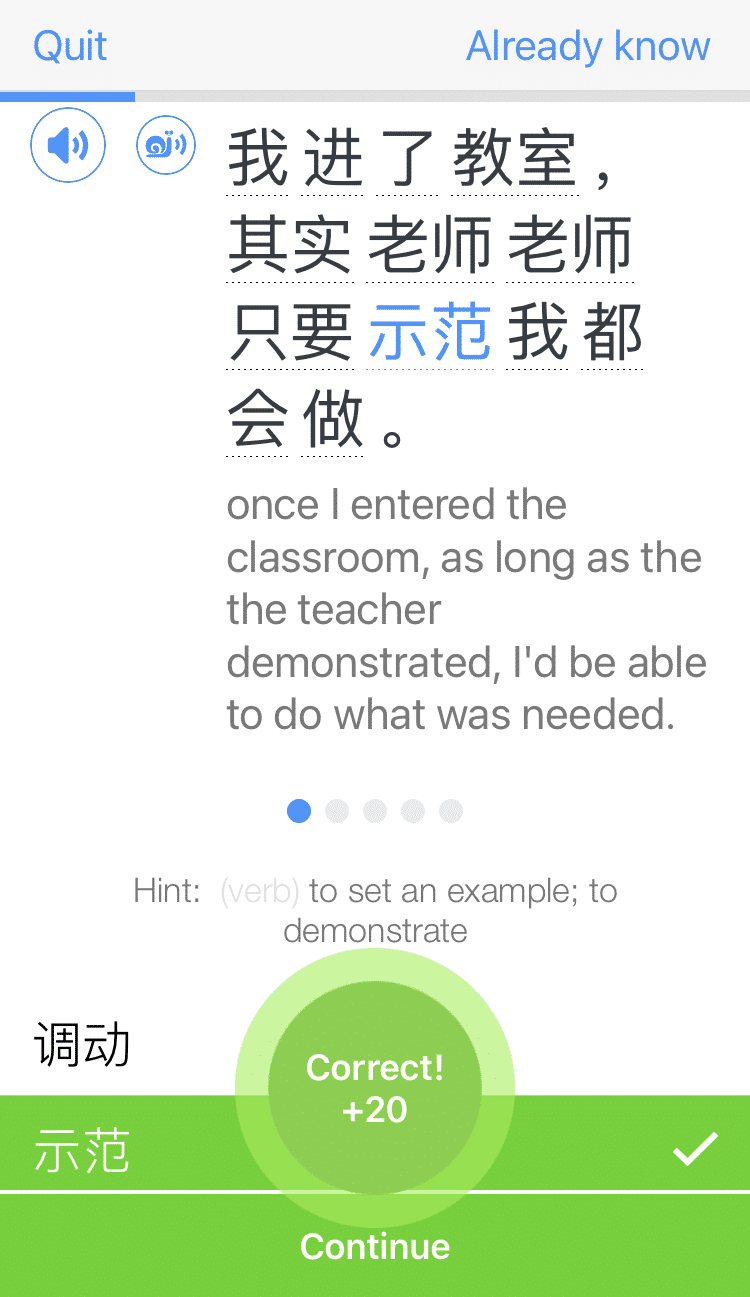
How to Learn Basic Chinese Grammar: 9 Tips for Building Strong Sentences
How many times have you been told that Chinese has no grammar?
In reality, Mandarin Chinese just has sentence patterns that are radically different from the ones in English.
It’s a very logical language, and there’s actually a direct, structured beauty to Chinese grammar.
For a deep dive into the Chinese language, here’s our complete guide on Chinese grammar.
But if you want to learn basic Chinese grammar first, the tips below will help you start building strong sentences.
Contents
- 9 Tips for Basic Chinese Grammar Mastery
-
- 1. Get the hang of basic sentence structure (S-V-O).
- 2. Learn when and how to use possessive words.
- 3. Negate a statement with 不 (bù) or 没 (méi).
- 4. Use 吗 (ma) to ask yes/no questions.
- 5. To answer a yes/no question, revert it back to a statement.
- 6. Always put adjectives before nouns.
- 7. Get used to the word order for adverbs and complements.
- 8. Remember that Chinese is topic-prominent.
- 9. Figure out when to use conjunctions and punctuations.
- How Important Is Chinese Grammar?
- Is Chinese Grammar Easy to Learn?
- And One More Thing...
Download: This blog post is available as a convenient and portable PDF that you can take anywhere. Click here to get a copy. (Download)
9 Tips for Basic Chinese Grammar Mastery
1. Get the hang of basic sentence structure (S-V-O).
Both English and Chinese follow the same sentence structure for the most part: Subject + Verb + Object, also known as S-V-O.
Let’s look at a phrase in both English and Chinese:
她喜欢书籍。(tā xǐ huān shū jí.) — She likes books.
We can break it down like this:
- “She” and 她 (tā) are the subjects.
- “likes” and 喜欢 (xǐ huān) are the verbs.
- “books” and 书籍 (shū jí) are the objects.
Here are some more easy S-V-O sentences in Chinese:
我喜欢小笼包。(wǒ xǐ huān xiǎo lóng bāo.) — I like soup dumplings.
她看报纸。(tā kàn bào zhǐ.) — She reads the newspaper.
他们吃午餐。(tā men chī wǔ cān.) — They eat lunch.
It’s an extremely simple sentence order because it’s familiar for English speakers. This is the basic form of sentences you’ll learn to create as a beginner, and then build up from there.
2. Learn when and how to use possessive words.
有 (yǒu) or “have” is the main possessive word used in Mandarin. The other main word is 的 (de).
有 (yǒu) is used when explicitly saying that someone “has” something. For example:
我有一束可爱的椰子。(wǒ yǒu yī shù kě ài de yē zi.) — I have a lovely bunch of coconuts.
的 is used to passively mention something in one’s possession, be it a concept or actual object. Here are some examples:
我最好的朋友真棒。(wǒ zuì hǎo de péng yǒu zhēn bàng.) — My best friend is awesome.
你见过她的猫吗?(nǐ jiàn guò tā de māo ma?) — Have you seen her cat?
It helps to remember that 的 is a sort of “phrase linker.” When having a casual conversation, you can also omit 的 all together, as it’s implied by the context of the sentence. For example:
你见过她猫吗?(nǐ jiàn guò tā māo ma?) — Have you seen her cat?
3. Negate a statement with 不 (bù) or 没 (méi).
不 (bù)
How do you say you don’t do whatever verb’s in question? Easy—just add 不 (bù), the English equivalent to “don’t/doesn’t,” before the verb!
Take a look at the example phrases below:
我喜欢… (wǒ xǐ huān…) — I like…
我不喜欢… (wǒ bù xǐ huān…) — I don’t like…
我想要… (wǒ xiǎng yào…) — I want…
我不想要… (wǒ bù xiǎng yào…) — I don’t want…
她吃… (tā chī…) — She eats…
她不吃… (tā bù chī…) — She doesn’t eat…
没 (méi)
The only time when you can’t use 不 is when the verb is 有 (yǒu) or “have.” For “don’t have” in Chinese, you have to use 没 (méi), so you would say 没有 (méi yǒu).
没有 can also be used as a negative response to a “Do you have…” question. And yes, in this case, you literally would be saying, “I don’t have” as your reply, but the proper translation would simply be, “No.”
我没有狗。(wǒ méi yǒu gǒu.) — I don’t have a dog.
她没有妹妹。(tā méi yǒu mèi mei) — She doesn’t have a sister.
你有铅笔吗?(nǐ yǒu qiān bǐ ma?) — Do you have a pencil?
对不起。我没有。(duì bù qǐ. wǒ méi yǒu.) — Sorry. I don’t/No.
不 and 没 are used everywhere (and for different situations), so it’s one of the most important grammar points in Chinese!
As a beginner, you’d probably enjoy watching short Chinese videos or cartoons where you can hear these grammar concepts being used over and over. For instance, FluentU lets you absorb grammar more naturally through Chinese videos.
FluentU takes authentic videos—like music videos, movie trailers, news and inspiring talks—and turns them into personalized language learning lessons.
You can try FluentU for free for 2 weeks. Check out the website or download the iOS app or Android app.
P.S. Click here to take advantage of our current sale! (Expires at the end of this month.)
4. Use 吗 (ma) to ask yes/no questions.
When asking questions in English, all you really need is that little inflection at the end of the sentence, personified by the question mark.
In Chinese, things are a bit different. For formal Mandarin, you use the punctuation word 吗 (ma).
Here are some examples:
你好吗?(nǐ hǎo ma?) — How are you?
你有什么食物吗?(nǐ yǒu shén me shí wù ma?) — Do you have any food?
You can actually transform sentences into yes-or-no questions simply by adding a 吗 at the end (along with a question mark, of course):
他起床了。(tā qǐ chuáng le.) — He got up.
他起床了吗?(tā qǐ chuáng le ma?) — Did he get up?
你喜欢看书。(nǐ xǐ huān kàn shū.) — You like reading books.
你喜欢看书吗?(nǐ xǐ huān kàn shū ma?) — Do you reading books?
她有一辆红色的车。(tā yǒu yī liàng hóng sè de chē.) — She has a red car.
她有一辆红色的车吗?(tā yǒu yī liàng hóng sè de chē ma?) — Does she have a red car?
吗 is pretty easy to use.
Just keep in mind that there are other kinds of questions you can ask in Chinese. 吗 is just used to ask a question that prompts a “yes” or “no” answer.
Alternative: Verb + Negation + Verb
Things get just a bit more complicated when we get into informal questions.
Formal: 你有时间吗?(nǐ yǒu shí jiān ma?) — Do you have the time?
Informal: 你有没有空?(nǐ yǒu méi yǒu kōng?) — Are you free?
When you use this form, you’re essentially saying “do or do not” or “have or don’t have” as the question marker. As negations, 没 (méi) and 不 (bù) can be used to follow this Verb + Negation + Verb pattern when asking a question.
If you’re having trouble getting used to this method, you can still use 吗 (ma) in informal situations and native Mandarin speakers will catch your drift. For the sake of fluency, though, it’s good to get a hang of the “have or don’t have” pattern.
5. To answer a yes/no question, revert it back to a statement.
Unfortunately, answers in Chinese aren’t as straightforward as a “yes” or “no” in English.
Let’s go back to this question:
他起床了吗?(tā qǐ chuáng le ma?) — “Did he get up?”
If you want to respond with a “yes,” all you have to do is turn it back into a statement:
他起床了 (tā qǐ chuáng le).
This would be translated as “He got up” when it’s a statement on its own, but as “yes” when it’s used as a reply to a question.
To say “no,” you would apply rule three about negation. It would look like this:
你喜欢看书吗?(nǐ xǐ huān kàn shū ma?) — Do you like reading books?
我不喜欢看书。(wǒ bù xǐ huān kàn shū.) — No/I don’t like reading books.
Remember that if the question contains 有, then your answer would have 没有.
你有哥哥吗?(nǐ yǒu gē gē ma?) — Do you have an older brother?
我没有哥哥。(wǒ méi yǒu gē gē.) — No/I don’t have an older brother.
There are actually more condensed ways to say “yes” and “no,” which will be explained later.
6. Always put adjectives before nouns.
Just like in English, adjectives are always placed right before the noun. Easy enough, right? Time for some examples.
他们吃白饭。(tāmen chī bái fàn.) — They eat (white) rice.
她想要一个大房子。(tā xiǎng yào yī gè dà fáng zi.) — She wants a big house.
我有一个高大的男朋友。(wǒ yǒu yī gè gāo dà de nán péng yǒu.) — I have a tall boyfriend.
A sigh of relief compared to the first rule, isn’t it? Now, onto the next one.
7. Get used to the word order for adverbs and complements.
Adverbs
Good ol’ adverbs. An adverb is a word that modifies an adjective, verb or additional adverb in a phrase. Sentence structure in Mandarin can get a bit tricky when adverbs are thrown into the mix, but it doesn’t have to be so tough.
A good rule of thumb is to know that adverbs in Mandarin always go before verbs or the words they modify. Thus, anything indicating when, where and how the action happened will always be placed before the verb. Here are some examples:
她刚 跑。(tā gāng pǎo.) — She just ran.
我没有时间。(wǒ méi yǒu shí jiān.) — I do not have time.
警察生气地 看 着我们。(jǐng chá shēng qì de kàn zhe wǒ men.) — The policeman watched us angrily.
If you have more than one adverb in a sentence, there’s an exact order you’ll have to follow: time, followed by place. For example:
我昨晚在家看电视 (wǒ zuó wǎn zài jiā kàn diàn shì) — “I watched TV at home last night.”
晚在 (zuó wǎn) means “last night,” while 在家 (zài jiā) means “at home.” You can see that the order is time, place and then finally the verb: 看电视 (kàn diàn shì) or “watch TV.”
Complements
Complements are a tricky subject since they’re hard to pinpoint in English translations. The main thing to know about them is that complements describe the result or degree of the verb.
When something is done very well, or 很好 (hěn hǎo), “very well” would be considered the complement.
In other instances, you can’t exactly identify the complement in an English translation. Here’s one example:
他听不懂。(tā tīng bù dǒng.) — He doesn’t understand.
The complement isn’t evident in English, but in Chinese, the main verb in question is 听 (tīng), or “listen.” 不懂 (bù dǒng) would be considered the result of 听 (tīng), with the long-winded explanation being that the man listened but didn’t understand what he was listening to.
Normally what comes after the main verb but before the object (if there is one) is what would be identified as the complement.
Examples
With that said, let’s look at some S-V-O examples with adverbials and complements.
他在图书馆学习得很好。(tā zài tú shū guǎn xué xí de hěn hǎo.) — He studies well at the library.
妈妈早上很快穿衣服。(mā mā zǎo shang hěn kuài chuān yī fú.) — Mom quickly gets dressed in the morning.
我吃过了小龙虾。(wǒ chī guò le xiǎo lóng xiā.) — I have eaten crayfish.
The tricky part here is understanding that adverbials and complements won’t always reflect in English translations. But with more practice, you’ll see that Chinese is very straightforward in its sentence order.
8. Remember that Chinese is topic-prominent.
O-S-V Sentence Structure
One of the biggest differences between Mandarin Chinese and English is the emphasis on the topic instead of the subject.
In English, sentences often highlight the performer of the action, making the subject an important part of statements and placed first in the sentence.
Chinese, on the other hand, is focused heavily on the topic (the theme or main information) of the sentence, giving speakers the option to place the topic before the subject.
Here’s an example sentence:
啤酒我不喜欢。(pí jiǔ wǒ bù xǐ huān.) — I don’t like beer.
The topic (啤酒 or “beer”) is the object, but it’s the first word in the sentence. This changes the word order from your regular S-V-O to O-S-V (object first).
The literal translation of the rearranged order would be, “Beer I don’t like,” and it still carries the same meaning as, “I don’t like beer.” In Chinese, both S-V-O and O-S-V formats are perfectly acceptable grammar structures.
Removing the Subject
Sometimes the subject isn’t even mentioned in the sentence, but the meaning is never lost because the subject is implied. One specific example would be a dialogue between two people, where the speakers don’t need to specify “I” or “you,” or in Chinese, 我 (wǒ) or 你 (nǐ).
Let’s look at some examples with implied subjects:
Q: 口香糖有吗?(kǒu xiāng táng yǒu ma?) — Do you have gum?
A: 有。(yǒu.) — I do/Yes.
Q: 作业做完了吗?(zuò yè zuò wán le ma?) — Did you finish your homework?
A: 还没有。(hái méi yǒu.) — Not yet/No.
Q: 眼镜找到了吗?(yǎn jìng zhǎo dào le ma?) — Did you find your glasses?
A: 找到了。(zhǎo dào le.) — Yes/Found them already.
As you can see, these are examples of informal dialogues, where the questions follow an O-V order. The subjects have been taken out in the exchange because it’s clear that the speakers are talking to each other.
And since the object was already clear in each of the questions, the second person in each dialogue only needs to reply with a verb (along with the necessary adverbials and/or complements). What’s great about this is that it eliminates unnecessary repetition, which you saw in the yes/no answers under rule five.
Like many other components of Mandarin Chinese, this can be confusing at first. For the time being, it’s okay to stick with the standard S-V-O structure, and soon after, you can begin experimenting with the O-S-V word order. Then when you find yourself in an informal conversation, try a couple of questions just using O-V.
9. Figure out when to use conjunctions and punctuations.
Punctuations
Chinese punctuation differs pretty significantly from English. Here are a few punctuation marks to remember when typing full sentences in Chinese:
- 。is used in place of a period.
- 、is used in place of a comma.
- 《…》is used to denote titles, such as books, films, articles, songs, etc.
- 「…」is essentially Chinese quotation marks. Use these when quoting someone directly.
Conjunctions
Punctuation may be simple in Mandarin, but conjunctions can get a bit trickier.
A conjunction is a word used to connect other words and phrases in a sentence.
Conjunctions can appear in pretty much any part of a sentence, but you can expect them to show up after a comma is used, like with English conjugations. Sometimes, though, a conjunction might appear after a subject, following the Comma + Subject + Conjunction pattern.
Here are a few examples of conjunctions used in Chinese:
我是艺术家、他也是艺术家。(wǒ shì yì shù jiā, tā yě shì yì shù jiā.) — I am an artist, he is also an artist.
我跟他去跑步。(wǒ gēn tā qù pǎo bù.) — I went running with him.
我喜欢猫 、可是猫不喜欢我。(wǒ xǐ huān māo, kě shì māo bù xǐ huān wǒ.) — I like cats, but cats don’t like me.
How Important Is Chinese Grammar?
- Understanding the foundation of Chinese grammar is crucial for fluency. Let’s assume that you, the reader, are a native English speaker. How far do you think you would’ve gotten in English if you didn’t understand the basics of grammar? If you’re a beginner Mandarin learner, it’s best to figure out grammar now rather than later.
- It’s the key to being able to correctly form your own sentences. Many beginner learners dive right into memorizing phrases and vocabulary words. This may work for learners who just want to learn passing Mandarin or Chinese for travel, but those who want to master the language need to understand Mandarin grammar in order to form sentences on the spot.
- It’s vastly different from English grammar. English and Chinese definitely have their similarities in terms of grammar, but for the most part, they’re nearly polar opposites. Not learning Chinese grammar now could lead to confusion and frustration once you hit a “learning block” in the future.
Is Chinese Grammar Easy to Learn?
While there are certain grammar differences that’ll require a bit of adjustment, Chinese grammar has a ton of features that make it relatively easy to learn, compared to other languages that you may have learned in the past.
Here are some facts about basic Chinese grammar that you might appreciate:
- Unlike many other languages, nouns don’t have genders in Mandarin.
- There are also no plural forms of words. Characters for nouns, pronouns and adjectives don’t change according to numbers. Rather, a phrase or a character will be added to denote the number of the object in question.
- Verbs stay exactly as is because there are no verb conjugations, no matter who’s performing the action.
- Because there are no verb conjugations, there are also no irregular verbs.
- Chinese verbs have only one form regardless of the tense. “Tenses” are understood in terms of the sentence’s context and aspect (this indicates the completeness of an action). You’ll explore the concept of aspect more after you’ve learned the basics.
Basic Chinese grammar isn’t as mysterious as one would think, right? As with any language, getting a grasp on grammar can make the process of learning Mandarin substantially easier.
Now that you have the tools to dive right into learning Chinese, get out there and 实践 (shí jiàn) — practice!
Download: This blog post is available as a convenient and portable PDF that you can take anywhere. Click here to get a copy. (Download)
And One More Thing...
If you want to continue learning Chinese with interactive and authentic Chinese content, then you'll love FluentU.
FluentU naturally eases you into learning Chinese language. Native Chinese content comes within reach, and you'll learn Chinese as it's spoken in real life.
FluentU has a wide range of contemporary videos—like dramas, TV shows, commercials and music videos.
FluentU brings these native Chinese videos within reach via interactive captions. You can tap on any word to instantly look it up. All words have carefully written definitions and examples that will help you understand how a word is used. Tap to add words you'd like to review to a vocab list.
FluentU's Learn Mode turns every video into a language learning lesson. You can always swipe left or right to see more examples for the word you're learning.
The best part is that FluentU always keeps track of your vocabulary. It customizes quizzes to focus on areas that need attention and reminds you when it’s time to review what you’ve learned. You have a 100% personalized experience.
Start using the FluentU website on your computer or tablet or, better yet, download the FluentU app from the iTunes or Google Play store. Click here to take advantage of our current sale! (Expires at the end of this month.)






